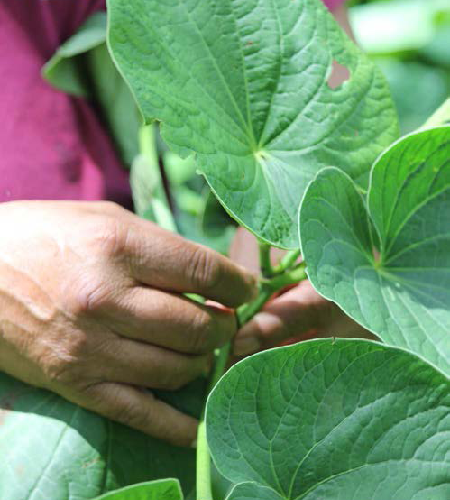By: Duke Morgan
Horticulturist, Waimea Valley Botanical Garden
Kalo or taro (Colocasia esculenta (L.) Schott) ‘the starchy staple of the pacific’, most likely a Polynesian introduction, has been cultivated and passed down by ohana and mahiai (planters) for thousands of years. Kalo is a beautiful plant in the plant family Araceae. Due to its mostly vegetative (non-seed producing, with exceptions) growth habit each individual plant was harvested, prepared in to huli (clonal planting material), and passed down by hand every time it was replanted/ moved. Food crops and humans have evolved together for hundreds of thousands of years. For kalo to survive numerous trans-pacific voyages, the health and care of the plant material was critical. It is thought that Hawaiian horticulturists grew the plants in ideal conditions, cut huli, wrapped and cared for them like children. Kalo huli were wrapped in a mixture of niu (coconut) fiber, tree fern pulu, kapa (bark cloth) and lau hala (Pandanus leaf plaiting) vessels to protect them from the numerous, rugged and grueling voyages, across the Pacific.
All kalo can be grown in a wet or a dry culture. Typically, more experienced growers have an understanding of which kalo they prefer for certain uses, as well as the best location to plant. In old Hawaii, mahiai were very well versed in the uses and culture of kalo and had specific ways to grow and care for the plants. One of the reasons that we have such a rich history with kalo is that for hundreds of years mahiai were selecting certain physical traits of kalo. This resulted in varieties which grew best in the uplands, salty environments, and wet vs. dry cultures. The need for paiai (freshly pounded kalo with little to no water added) to last long trips around the island or on long journeys on the canoe was crucial. Growing
certain varieties in loi (wet culture) produced corms that were much more dense than those grown in a mala (dry culture), this lead to a paiai that would not sour as quickly and last on longer journeys.
Awa or kava kava (Piper methysticum G.Forst) is revered in moolelo (lore) and laau lapaau (Hawaiian plant medicine) practices since the ancient times. Awa is a hardy, handsome shrub in the plant family
Piperaceae with long, knuckled stems, and heart shaped leaves. Typically in a vegetative growth state, the awa plant does flower, but seldom makes seed even when pollinated. For this reasonawa needs to
be propagated and selected by cuttings. It is speculated that awa was brought across the Pacific with the utmost care by early Polynesians. Certainawa varieties were integral in ceremonial and medicinal preparation. Knowing that you have a clone or an exact copy of the correct plant material was paramount in keeping akua (god/goddess) satisfied and the quality of medicine at the greatest efficacy. It is critical as a mahiai to only share clean, vigorous huli and cuttings. Although many mahiai are good stewards, plant diseases and insect pests do not take a day off, so best practice is to not introduce any unwanted pathogens or pests to your mala. A few common pests and diseases of kalo to be vigilant about are: aphids, leaf hoppers, root mealy bugs, slugs, snails, chickens, pigs and leaf blights (fungal spots). Most of these can be treated culturally by removing infected material, organically controlling insects, slugs and snails (soaps, horticultural oils, physical removal, fencing) and by feeding, watering, and mulching your plants regularly. If you have any questions or concerns with you gardens and trees please feel free to stop by or contact me directly at: dmorgan@waimeavalley.net
Due to Governor Ige’s latest guidelines and restrictions on social gatherings we are postponing the annual Kalo & Awa Festival to November 2021. We hope that by then the current COVID-19 cases in Hawaii have drastically gone down and we able to gather as a community once again. Please stay posted to our social media @waimeavalleyoahu, @waimeavalley and www.waimeavalley.net/events on event dates, changes, and details. We hope everyone stays safe and healthy. Aloha and a hui hou.



